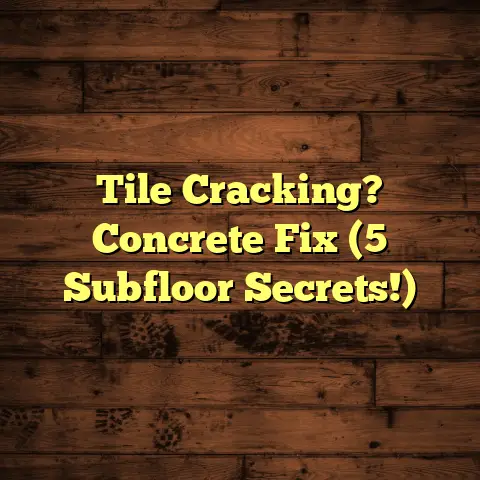Buying Hardwood: Key Things (7 Unseen Flaws)
“Quality is not an act, it is a habit.” – Aristotle
Introduction
Hardwood flooring. Isn’t it just gorgeous?
It’s got that timeless aesthetic, the kind that instantly elevates any space.
Plus, it’s durable, and let’s be honest, it adds a real punch to your home’s value.
But here’s the thing: buying hardwood isn’t always as straightforward as it seems.
There are a ton of misconceptions floating around, and honestly, a lot of potential pitfalls that aren’t immediately obvious.
That’s where I come in. I’ve spent years knee-deep in sawdust, installing and dealing with all kinds of hardwood flooring.
I’ve seen it all, believe me.
In this article, I’m going to walk you through seven critical, often unseen flaws that you absolutely need to look out for when you’re buying hardwood.
Trust me, knowing these things can save you a ton of headaches, money, and heartache down the road.
Section 1: Understanding Hardwood Types
Okay, let’s start with the basics. Not all hardwood is created equal.
You’ve got your oaks, your maples, your cherries – each with its own personality and quirks.
Oak, for example, is a classic for a reason. It’s durable, readily available, and takes stain really well. Think traditional, timeless.
Maple, on the other hand, is known for its smooth, consistent grain.
It’s a bit more modern and can brighten up a room beautifully.
Cherry is all about that rich, reddish-brown hue. It’s elegant, but it’s also a bit softer than oak or maple, so keep that in mind.
And then there’s hickory, walnut, ash… the list goes on.
But here’s the key: the type of wood you choose will absolutely influence the look, the durability, and even the maintenance of your floor.
Think about your lifestyle. Do you have kids and pets running around?
You’ll probably want something super durable like oak or hickory.
Are you going for a sleek, minimalist vibe? Maple might be your jam.
And don’t forget about your existing home decor. You want your floors to complement your style, not clash with it.
Section 2: The Unseen Flaw #1: Moisture Content
Alright, let’s dive into the first unseen flaw: moisture content.
This is a big one, folks. It can make or break your entire flooring project.
See, wood is a natural material, and it’s constantly absorbing and releasing moisture depending on the environment.
If the moisture content of your hardwood isn’t right before you install it, you’re asking for trouble.
Too much moisture, and the boards will swell and potentially buckle or warp.
Too little, and they’ll shrink, leaving unsightly gaps between the planks.
I’ve seen it happen so many times, and it’s not pretty.
So, how do you avoid this disaster?
First, ask the supplier about the moisture content of the wood.
Ideally, it should be within the range of 6-9% for most regions.
Second, invest in a moisture meter.
These aren’t super expensive, and they’re worth their weight in gold.
You can use it to test the moisture content of the wood yourself before you even bring it into your house.
Third, acclimate the wood to your home’s environment before installation.
This means letting it sit in the room where it will be installed for several days, allowing it to adjust to the temperature and humidity.
I usually recommend at least 3-5 days, but longer is always better.
I remember one job where the homeowner insisted on installing the wood immediately, even though I told them it hadn’t acclimated properly.
A few months later, they called me back complaining about huge gaps between the boards. I had to break the bad news to them.
Don’t be that homeowner. Trust me on this one.
Section 3: The Unseen Flaw #2: Wood Grain and Aesthetic Flaws
Okay, let’s talk about aesthetics.
Wood grain patterns are like snowflakes – no two are exactly alike.
You’ll see everything from straight, uniform grains to wild, swirling patterns.
And then there are knots, color variations, and blemishes.
Some people love these natural characteristics; they add character and charm.
Others prefer a more consistent, uniform look.
The key is to know what you’re getting and what you like.
Inspect multiple boards before you buy.
Don’t just look at the sample board in the showroom.
Ask to see a full box or even a pallet of wood.
This will give you a much better idea of the overall visual consistency.
Here’s a pro tip: lay out a few boards on the floor to get a sense of how they’ll look together in a larger space.
Pay attention to the color variation.
Are there drastic differences between boards?
Are there too many knots for your liking?
Do the grain patterns complement each other?
I once had a client who was obsessed with perfectly uniform wood.
They rejected almost half the boards because they had tiny knots or slight color variations.
It was a bit extreme, but it just goes to show how important it is to have a clear vision of what you want.
Section 4: The Unseen Flaw #3: Finish Quality
Alright, let’s talk finish. This is what protects your hardwood from the daily grind – scratches, spills, and general wear and tear.
There are a ton of different finishes out there, from polyurethane to oil-based to water-based.
Polyurethane is a classic choice. It’s durable, affordable, and provides a good level of protection.
Oil-based finishes tend to have a warmer, richer look, but they can take longer to dry and may require more maintenance.
Water-based finishes are low-VOC (volatile organic compounds), which means they’re more environmentally friendly.
They also tend to dry faster and are less likely to yellow over time.
But here’s the thing: the quality of the finish matters just as much as the type.
A cheap, poorly applied finish will scratch and wear down quickly, leaving your floors looking dull and beat-up.
So, how do you evaluate the finish quality?
First, ask about the number of coats applied.
Ideally, you want at least three coats for good protection.
Second, look for a finish with a good reputation.
Do some research online and read reviews.
Third, perform a scratch test.
Take a coin or a key and gently scratch the surface of a sample board.
If the finish scratches easily, it’s probably not very durable.
I remember one job where the homeowner insisted on using a super cheap finish.
I tried to warn them, but they wouldn’t listen.
Within a year, their floors were covered in scratches and looked terrible.
They ended up having to sand them down and refinish them with a better-quality product, which cost them way more in the long run.
Learn from their mistake!
Section 5: The Unseen Flaw #4: Installation Method and Subfloor Compatibility
Okay, let’s talk about installation.
There are three main methods: nail-down, glue-down, and floating.
Nail-down is the traditional method. It’s typically used for solid hardwood floors. The boards are nailed directly to the subfloor.
Glue-down is exactly what it sounds like. The boards are glued to the subfloor using a special adhesive.
This method is often used for engineered hardwood.
Floating floors aren’t attached to the subfloor at all.
Instead, the boards are connected to each other, creating a single, large “floating” surface.
This method is popular for DIY projects because it’s relatively easy to install.
But here’s the thing: the installation method has to be compatible with your subfloor.
If you have a concrete subfloor, you can’t nail down solid hardwood.
You’ll need to use a glue-down or floating method.
If your subfloor is uneven, you’ll need to level it out before installing any type of hardwood.
Otherwise, you’ll end up with a bouncy, uneven floor that feels terrible underfoot.
And don’t forget about moisture!
If your subfloor is damp, you’ll need to address the moisture issue before installing hardwood.
Otherwise, the moisture will seep into the wood and cause it to warp or buckle.
I’ve seen so many installation disasters caused by improper subfloor preparation.
It’s not worth the risk. Take the time to do it right.
Section 6: The Unseen Flaw #5: Warranty and Return Policy
Alright, let’s talk about warranties.
This is the fine print that nobody wants to read, but it’s super important.
A good warranty can protect you from defects in materials and workmanship.
But not all warranties are created equal.
Some are very comprehensive, while others are full of exclusions and limitations.
Here are a few things to look for in a hardwood flooring warranty:
- Coverage: What exactly is covered by the warranty? Does it cover defects in the wood itself, or just the finish? Does it cover installation?
- Duration: How long does the warranty last? Some warranties only last a year or two, while others last for 25 years or more.
- Exclusions: What is not covered by the warranty? Common exclusions include damage caused by moisture, pets, or improper maintenance.
- Claims process: How do you file a warranty claim? What documentation do you need to provide?
And don’t forget about the return policy!
What happens if you buy a bunch of hardwood and then realize it’s not the right color or style for your home?
Can you return it for a full refund?
Most retailers have a return policy, but the terms can vary widely.
Make sure you understand the return policy before you buy.
I remember one client who bought a huge amount of hardwood online without reading the fine print.
When it arrived, they realized it was the wrong color.
They tried to return it, but the retailer refused because they were outside the return window.
They were stuck with a pile of hardwood they couldn’t use.
Don’t let that happen to you!
Section 7: The Unseen Flaw #6: Environmental Impact and Sustainability
Okay, let’s talk about something that’s near and dear to my heart: environmental impact.
Where does your hardwood come from? Was it harvested sustainably?
These are important questions to ask.
Unsustainable logging practices can lead to deforestation, habitat loss, and other environmental problems.
Plus, wood that’s harvested illegally or unsustainably may be of lower quality.
So, how can you make sure you’re buying hardwood that’s environmentally responsible?
- Look for certifications. The Forest Stewardship Council (FSC) certification is the gold standard for sustainable forestry.
- Ask about the origin of the wood. Where was it harvested? What are the logging practices?
- Consider reclaimed wood. Reclaimed wood is wood that’s been recycled from old buildings or other sources. It’s a great way to reduce your environmental impact and add character to your home.
Here are some globally recognized certification organizations:
| Name | Description |
|---|---|
| Forest Stewardship Council (FSC) | The FSC is widely regarded as the most credible forestry certification system globally. It sets high standards for forest management, ensuring that forests are managed in an environmentally appropriate, socially beneficial, and economically viable manner. FSC certification covers the entire chain of custody, from the forest to the end consumer. |
| Programme for the Endorsement of Forest Certification (PEFC) | PEFC is an umbrella organization that endorses national forest certification systems developed through multi-stakeholder processes tailored to local conditions. It promotes sustainable forest management through independent third-party certification. PEFC is particularly strong in Europe but has a global presence. |
| Sustainable Forestry Initiative (SFI) | SFI is a North American certification program that promotes responsible forest management. It focuses on protecting biodiversity, water quality, and wildlife habitat. SFI standards are based on principles of sustainable forest management and are independently audited. While it is primarily used in North America, it is recognized internationally. |
| American Tree Farm System (ATFS) | ATFS is the largest and oldest sustainable woodland system in the United States. It focuses on family-owned forests and emphasizes sustainable forest management practices that protect watersheds, wildlife habitat, and recreational opportunities. Certification under ATFS ensures that landowners are managing their forests according to sustainable principles. |
| Canadian Standards Association (CSA) | CSA develops standards for sustainable forest management that are used in Canada. These standards address environmental, social, and economic aspects of forestry. CSA certification is recognized in Canada and internationally and is often used in conjunction with other certification systems like PEFC. |
| Pan European Forest Council (PEFC) | Although mentioned as an umbrella organization, it’s important to reiterate PEFC’s strong presence in Europe. It is a key certification system that ensures forests are managed sustainably according to regional standards. |
| Rainforest Alliance Certified | The Rainforest Alliance offers certification for responsible forest management, ensuring that forests are managed in a way that protects biodiversity, safeguards the rights and well-being of workers and local communities, and promotes sustainable livelihoods. While not exclusively focused on forestry, their certification programs also cover agricultural and tourism sectors. |
I always try to source my wood from sustainable sources.
It’s not always the cheapest option, but it’s the right thing to do.
Section 8: The Unseen Flaw #7: Cost vs. Value
Okay, let’s talk about the bottom line: cost.
Hardwood flooring can be a significant investment.
But don’t just focus on the upfront price.
Think about the long-term value.
A cheap hardwood floor might save you money in the short term, but it could end up costing you more in the long run if it wears out quickly or requires a lot of maintenance.
Here are a few factors to consider when evaluating the value of hardwood flooring:
- Longevity: How long will the floor last? A well-maintained hardwood floor can last for decades.
- Maintenance: How much maintenance will the floor require? Some finishes are easier to clean and maintain than others.
- Resale value: Will the floor increase the value of your home? Hardwood flooring is generally considered a desirable feature by homebuyers.
Consider total cost of ownership:
I always encourage my clients to think about the total cost of ownership, not just the initial price.
This includes the cost of the flooring itself, the cost of installation, the cost of maintenance, and the potential cost of repairs or replacement.
Sometimes, it makes sense to spend a little more upfront to get a higher-quality floor that will last longer and require less maintenance.
I had a client who was torn between two different hardwood floors.
One was cheaper but had a lower-quality finish.
The other was more expensive but had a much more durable finish.
I advised them to go with the more expensive option, and they were glad they did.
Years later, their floors still look great, while their neighbors who went with the cheaper option had to refinish their floors after just a few years.
Conclusion
So, there you have it – seven unseen flaws to look out for when buying hardwood flooring.
- Moisture content: Make sure the wood is properly acclimated.
- Wood grain and aesthetic flaws: Inspect multiple boards before you buy.
- Finish quality: Choose a durable finish with a good reputation.
- Installation method and subfloor compatibility: Make sure the installation method is compatible with your subfloor.
- Warranty and return policy: Understand the terms of the warranty and return policy.
- Environmental impact and sustainability: Choose hardwood from sustainable sources.
- Cost vs. value: Think about the long-term value, not just the upfront price.
Buying hardwood flooring can be a daunting task, but with a little knowledge and preparation, you can avoid these common pitfalls and end up with beautiful, long-lasting floors that you’ll love for years to come.
So, go out there and approach your flooring purchase with knowledge and confidence! You got this!





